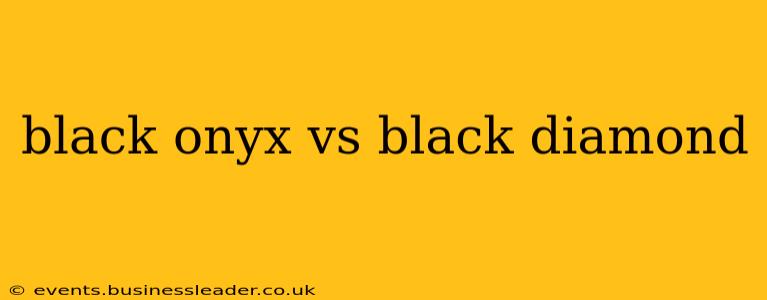Black onyx and black diamonds are both captivating gemstones known for their deep, dark allure. However, despite their similar appearances, these two stones possess vastly different properties, origins, and ultimately, values. This comprehensive guide delves into the key distinctions between black onyx and black diamonds, helping you understand their unique characteristics and choose the perfect gem for your needs.
What is Black Onyx?
Black onyx is a variety of chalcedony, a cryptocrystalline form of quartz. Its intense black color is typically attributed to the presence of trace elements and inclusions within the stone. While often appearing jet black, some pieces may exhibit subtle variations in shade or banding. Black onyx is relatively abundant and widely available, making it a more affordable gemstone option compared to black diamonds. It's often used in jewelry, carvings, and decorative objects.
What is a Black Diamond?
Unlike black onyx, a black diamond is a naturally occurring form of diamond. Its dark hue results from numerous tiny inclusions within the crystal structure, often graphite or other carbon-based materials that scatter light, preventing its transmission and giving the diamond its characteristic black color. Black diamonds are significantly rarer than other diamond colors, making them highly sought after and correspondingly more expensive. The quality of a black diamond is determined not only by its color but also by its clarity, cut, and carat weight.
Black Onyx vs. Black Diamond: Key Differences
Here's a table summarizing the core differences between black onyx and black diamonds:
| Feature | Black Onyx | Black Diamond |
|---|---|---|
| Mineral Type | Chalcedony (cryptocrystalline quartz) | Diamond (pure carbon) |
| Hardness | 6.5-7 on the Mohs scale | 10 on the Mohs scale |
| Rarity | Relatively common | Relatively rare |
| Price | Significantly more affordable | Significantly more expensive |
| Luster | Waxy to vitreous | Adamantine (brilliant) |
| Transparency | Typically opaque | Can range from opaque to slightly translucent |
| Formation | Formed in volcanic cavities or geodes | Formed under high pressure and temperature |
How Can I Tell the Difference?
Distinguishing between black onyx and a black diamond can be straightforward with a few simple observations. Black diamonds, due to their superior hardness, possess a noticeable brilliance even in their dark color. They often exhibit a slight sparkle or reflection of light, whereas black onyx typically shows a duller, less vibrant surface. Furthermore, a simple hardness test (scratching the stone with a steel object) is a definitive method: onyx will be scratched, while a diamond will not. However, it's always recommended to consult a gemologist for precise identification.
Are Black Onyx and Black Diamonds Durable for Jewelry?
Black Onyx: While less hard than a diamond, black onyx is reasonably durable for everyday wear in jewelry. However, it’s susceptible to scratching and chipping if subjected to harsh impacts.
Black Diamond: Black diamonds are exceptionally durable due to their superior hardness. They can withstand everyday wear and tear without significant damage.
Which Stone is Right for Me?
The choice between black onyx and a black diamond depends largely on your budget and preferences. If you desire a strikingly dark gemstone without a hefty price tag, black onyx is an excellent choice. However, if you seek the unparalleled rarity, durability, and brilliance of a true diamond, then a black diamond is the superior option.
What are the different treatments for black onyx?
Often, black onyx undergoes dyeing or heat treatment to enhance its color and remove any lighter bands. This should be taken into account when making your purchase.
How are black diamonds graded?
The grading of black diamonds differs from that of other colored diamonds, primarily focusing on clarity and overall darkness rather than color saturation.
What is the meaning of the black onyx stone?
In many cultures, black onyx is associated with protection, strength, and grounding energy.
This comprehensive comparison should give you a clearer understanding of the differences between these two distinct gemstones. Remember, the best choice depends entirely on your personal style, budget, and desired characteristics in a gemstone.
